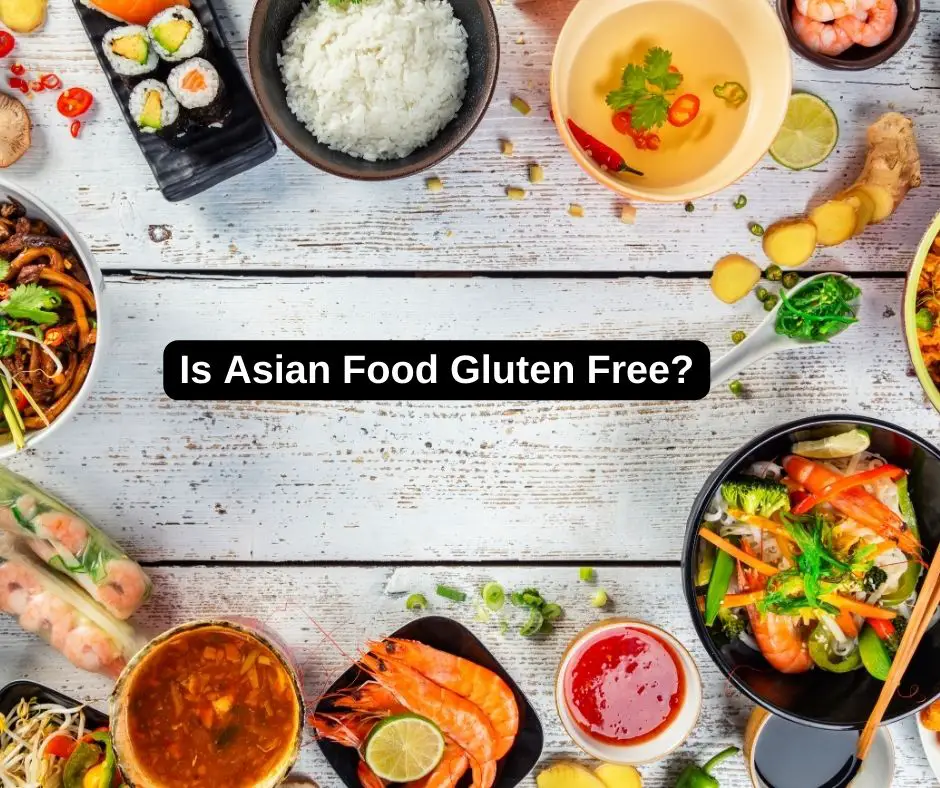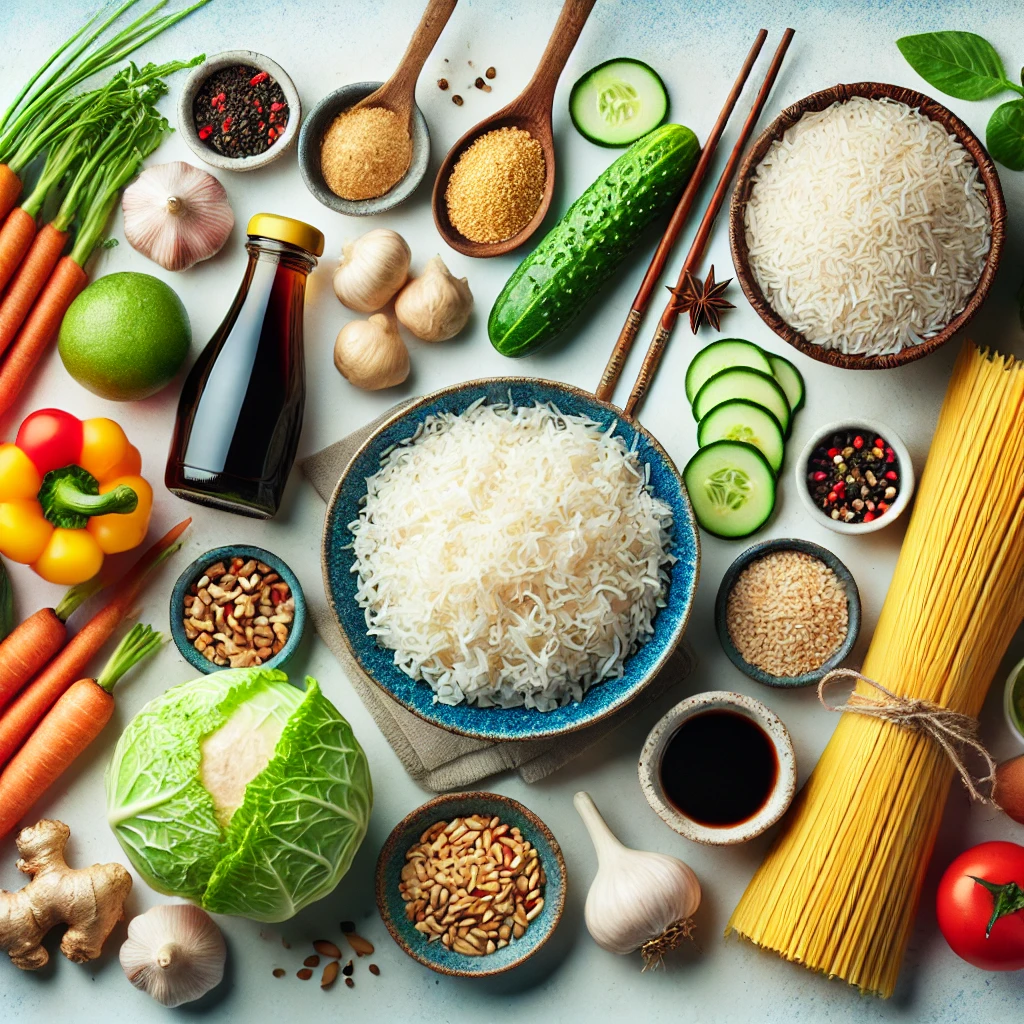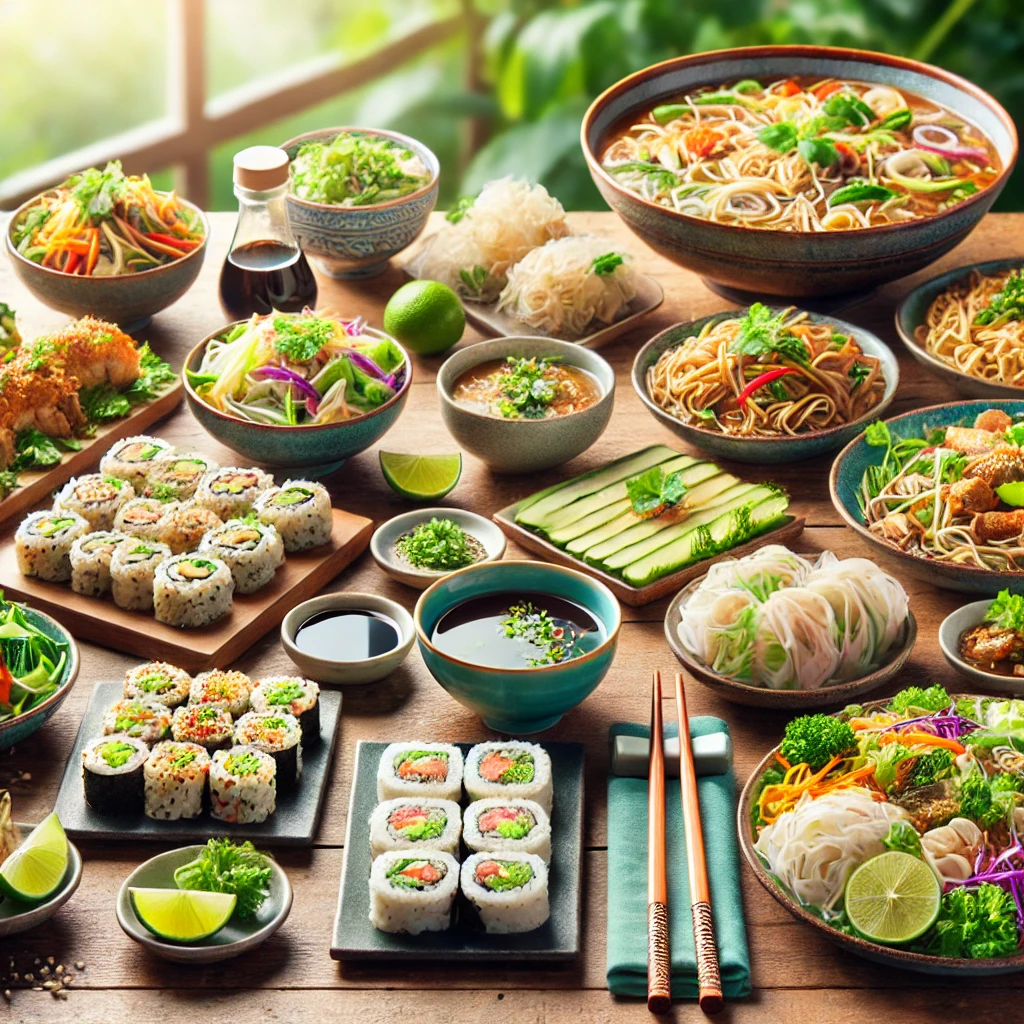Introduction: Is Asian Food Gluten Free? Asian cuisine is renowned for its diverse flavors, aromatic spices, and many dishes that tantalize the taste buds. However, exploring foreign culinary delights can sometimes be challenging for those who follow a gluten-free diet. In this article, we’ll delve into the question: Is Asian Food Gluten Free?
We’ll uncover the nature of gluten, explore its presence in Asian cuisine, highlight gluten-free options, address cross-contamination concerns, provide tips for safely enjoying Asian food on a gluten-free diet, share gluten-free Asian recipes, and ultimately help you make informed choices.

In recent years, gluten has gained significant attention due to the rise in gluten-related disorders and increased awareness of dietary restrictions. Many individuals are now adopting gluten-free diets to manage celiac disease and gluten sensitivity or to improve overall health. However, it’s essential to understand the nature of gluten and its presence in various food cultures, including Asian cuisine. Let’s read Is Asian Food Gluten Free?
Table of Contents
Understanding Gluten
Gluten is a protein combined found in wheat, barley, and rye grains. It provides elasticity to dough, giving bread its characteristic chewy texture. However, for individuals with gluten-related disorders, consuming gluten can trigger adverse reactions, leading to various symptoms like digestive discomfort, fatigue, and even damage to the small intestine.
Gluten-Related Disorders
Gluten-related disorders include celiac disease, wheat allergy, and non-celiac gluten sensitivity. Celiac disease is an autoimmune condition where its consumption causes the immune system to weak the small intestine lining.
Wheat allergy is an allergic response to wheat proteins, including gluten, which can cause symptoms ranging from mild to severe. Non-celiac gluten sensitivity is when individuals experience symptoms similar to celiac disease but lack the same immune response and intestinal damage.
Gluten in Asian Cuisine
Asian cuisine is diverse and encompasses various dishes from various countries, including China, Japan, Thailand, and India. While Asian cuisine heavily relies on rice and rice-based products, gluten-containing ingredients are also commonly used.
Rice and Gluten
Rice, a staple in many Asian countries, is naturally gluten-free and can be safely ingested by individuals on a gluten-free diet. Rice is the primary grain used in fried rice, rice noodles, and sushi, making them suitable options for those avoiding gluten.
Noodles and Gluten
Noodles are a prominent component of many Asian dishes. Traditional wheat-based noodles, such as ramen or udon, contain gluten and should be neglected by individuals with gluten-related disorders.
However, gluten-free alternatives made from rice, mung bean, or sweet potato flour are increasingly available, providing safe options for gluten-sensitive individuals.
Soy Sauce and Gluten
Soy sauce, a widely used condiment in Asian cooking, traditionally contains wheat as a key ingredient. It poses a challenge for individuals on a gluten-free diet, as regular soy sauce contains gluten. However, gluten-free tamari, a similar sauce made without wheat, is a suitable alternative that can use in Asian dishes without sacrificing flavor.
Gluten-Free Options in Asian Food

Despite the presence of gluten in certain Asian dishes, numerous gluten-free options are available to cater to individuals with dietary restrictions. Here are some examples:
Rice-based Dishes
Asian cuisine offers abundant rice-based dishes, including steamed rice, fried rice, and rice noodle dishes like Pad Thai. These dishes are typically gluten-free and can enjoy without concern.
Gluten-Free Noodles
Gluten-free noodles made from rice, sweet potato, or mung bean flour are increasingly popular. These can be found in Asian supermarket stores or substituted in recipes that call for wheat-based noodles, allowing individuals to enjoy stir-fries, noodle soups, and other Asian noodle dishes.
Tamari and Gluten-Free Soy Sauce
Gluten-free tamari, a wheat-free soy sauce alternative, is widely available and can be used as a replacement for regular soy sauce. It allows individuals to enjoy the umami flavor in their favorite Asian dishes while adhering to a gluten-free diet.
Cross-Contamination Concerns
Cross-contamination can occur when gluten-free dishes come into contact with gluten-containing ingredients or surfaces during preparation or cooking. In Asian restaurants, it’s important to be aware of this risk, as shared cooking utensils or fryers may lead to unintentional gluten exposure.
Communicating your dietary needs to restaurant staff and asking about cross-contamination precautions can help minimize this risk.
Eating Asian Food Safely on a Gluten-Free Diet
When dining out or preparing Asian food at home, there are several steps you can take to ensure a safe and enjoyable gluten-free experience:
- Research and choose restaurants that offer gluten-free options or have a good understanding of gluten-related dietary restrictions.
- Read ingredient labels carefully when purchasing Asian food products to identify potential hidden sources of gluten.
- Prepare Asian dishes at home using gluten-free ingredients and cooking methods to maintain control over the entire cooking process.
- Communicate your dietary needs to restaurant staff and ask about cross-contamination risks and gluten-free options.
Gluten-Free Asian Recipes
Here are a few gluten-free Asian recipes to inspire your culinary adventures:
Gluten-Free Teriyaki Chicken: A flavorful chicken dish marinated in gluten-free teriyaki sauce, served with steamed rice and vegetables.
Thai Green Curry with Gluten-Free Tamari: A vibrant and aromatic curry prepared with gluten-free tamari, coconut milk, vegetables, and your choice of protein.
Is sushi gluten-free?
Sushi can be gluten-free if prepared with gluten-free ingredients. However, some types of sushi may contain gluten-containing sauces or imitation crab made with wheat. Checking the ingredients or communicating your dietary needs when ordering sushi is essential.
Can I eat dim sum on a gluten-free diet?
Dim sum dishes often contain wheat wrappers, so it’s crucial to inquire about gluten-free options or look for gluten-free dim sum recipes that use alternative wrappers made from rice or tapioca flour.
Are spring rolls gluten-free?
Traditional spring rolls are typically made with wheat wrappers and are not gluten-free. However, rice paper wrappers are available, allowing for gluten-free spring roll alternatives.
Is miso soup gluten-free?
Miso soup can contain gluten if it includes barley-based miso paste. However, gluten-free miso paste made from soybeans or rice is available, enabling individuals to enjoy gluten-free miso soup.
Can I eat Thai curry on a gluten-free diet?
Thai curries can be gluten-free if prepared with gluten-free curry pastes and sauces. It’s important to check the ingredient labels or inquire about gluten-free options when dining out.
What are common hidden sources of gluten in Asian cuisine?
While many Asian dishes appear gluten-free, hidden sources of gluten can include soy sauce (which traditionally contains wheat), marinades, and certain condiments. Additionally, some noodles and dumplings are made with wheat flour. It’s essential to inquire about ingredients and opt for gluten-free alternatives like tamari or rice noodles when necessary.
How can I ensure a dish is gluten-free when dining at an Asian restaurant?
To ensure a dish is gluten-free, communicate your dietary needs clearly to the restaurant staff. Ask about the ingredients used, particularly in sauces and broths. Request the use of gluten-free alternatives and inquire about the risk of cross-contamination in the kitchen. Choosing restaurants that offer a dedicated gluten-free menu can also provide peace of mind.
Are rice-based dishes in Asian cuisine always gluten-free?
Rice itself is naturally gluten-free, making plain rice-based dishes generally safe. However, caution is needed with fried rice or flavored rice dishes, as they may include soy sauce or other additives containing gluten. Always verify the ingredients used in the preparation to ensure they meet gluten-free standards.
Is sushi safe for a gluten-free diet?
Sushi can be safe for a gluten-free diet if prepared with gluten-free ingredients. While the main components like rice, fish, and vegetables are gluten-free, caution is needed with soy sauce, imitation crab, and certain marinades that may contain gluten. Opt for gluten-free tamari and verify the ingredients used to ensure safety.
What gluten-free alternatives can I use in Asian cooking at home?
For home cooking, consider using gluten-free tamari instead of traditional soy sauce, rice noodles instead of wheat-based noodles, and gluten-free flours for battering and thickening. Additionally, many Asian markets offer gluten-free versions of common ingredients, allowing you to recreate authentic flavors safely.
How can I prevent cross-contamination when preparing gluten-free Asian dishes at home?
Prevent cross-contamination by thoroughly cleaning all cooking surfaces, utensils, and cookware before preparation. Use separate utensils for gluten-free cooking, store gluten-free ingredients separately, and ensure that shared appliances like toasters or cutting boards are free from gluten residues.
Are there specific Asian cuisines that are more gluten-free friendly?
Certain Asian cuisines, such as Thai and Vietnamese, often utilize rice and rice-based products, making them more accommodating to gluten-free diets. However, it’s still important to verify ingredients and preparation methods, as some dishes may include gluten-containing sauces or additives.
Can I find gluten-free soy sauce in regular grocery stores?
Yes, gluten-free soy sauce, commonly known as tamari, is widely available in many grocery stores and health food shops. It’s a suitable alternative for those avoiding gluten and can be used in the same way as traditional soy sauce to add umami flavor to dishes.
Conclusion: Is Asian Food Gluten Free?
While Asian cuisine offers various flavors and dishes, not all are gluten-free. Individuals on a gluten-free diet must understand the presence of gluten in certain Asian foods while being aware of gluten-free alternatives.
By making informed choices, communicating dietary needs, and exploring gluten-free Asian recipes, individuals can savor the delights of Asian cuisine without compromising their health.
What types of Asian noodles are typically gluten-free?
Noodles made from rice, sweet potato, or mung bean starch are typically gluten-free. Varieties such as rice vermicelli, glass noodles, and sweet potato noodles are excellent choices for gluten-free diets. However, always check packaging labels for potential gluten-containing additives or cross-contamination warnings to ensure safety.
How do I know if a dish uses gluten-containing thickeners?
Many Asian dishes use thickeners like wheat-based soy sauce, flour, or roux in sauces and soups. To avoid gluten, choose dishes that rely on naturally gluten-free thickeners, such as cornstarch, tapioca starch, or rice flour. When dining out, ask the chef or server how the dish is prepared and if gluten-free alternatives can be used.
Tips for Dining Out at Asian Restaurants on a Gluten-Free Diet
Navigating a gluten-free diet while dining out at Asian restaurants can be a delightful experience with a bit of preparation and knowledge. Asian cuisines offer a variety of naturally gluten-free dishes, but hidden sources of gluten in sauces and preparation methods can pose challenges. Here are practical tips to help you enjoy your meal safely and confidently.
Research the Menu in Advance
Before visiting an Asian restaurant, check their menu online to identify gluten-free options. Many restaurants label their dishes or offer dedicated gluten-free menus, making it easier to plan your order. Researching beforehand saves time and ensures a stress-free dining experience.
Communicate Clearly with Staff
Inform your server about your gluten-free dietary needs. Use clear language and explain that gluten is found in wheat, barley, and rye. Some staff members may not be familiar with the term “gluten,” so providing examples of gluten-containing ingredients, such as soy sauce or flour, can be helpful.
Ask Questions About Ingredients
Don’t hesitate to inquire about the preparation of dishes. Ask if soy sauce is used, whether marinades contain wheat, or if flour is used as a thickener in sauces or soups. Confirm if gluten-free alternatives, such as tamari or cornstarch, can be substituted.
Be Cautious with Sauces
Many Asian dishes rely on flavorful sauces like soy sauce, oyster sauce, or hoisin sauce, which often contain gluten. Request dishes without these sauces or ask if gluten-free versions are available. Tamari is a common gluten-free substitute for soy sauce and is increasingly offered at restaurants.
Opt for Naturally Gluten-Free Dishes
Choose dishes that are inherently gluten-free, such as steamed rice, sushi (without imitation crab or soy sauce), rice noodle-based dishes, and fresh spring rolls made with rice paper. These options minimize the risk of gluten exposure.
Avoid Fried Foods
Fried foods may be prepared in shared fryers, leading to cross-contamination with gluten-containing items. If you want a fried dish, ask if the restaurant uses a dedicated fryer for gluten-free options.
Watch for Hidden Sources of Gluten
Be aware of less obvious sources of gluten, such as batter coatings, soup bases, or seasoning packets. Clarify how the dish is seasoned and ask for gluten-free alternatives when possible.
Consider Dining at Gluten-Free-Friendly Restaurants
Choose Asian restaurants that specialize in gluten-free cuisine or have a reputation for accommodating dietary restrictions. These establishments are more likely to understand your needs and offer a wider range of safe options.
Bring Your Own Gluten-Free Sauce
For added peace of mind, consider carrying a small bottle of gluten-free tamari or soy sauce substitute. This ensures you can enjoy the full flavor of your dish without worrying about gluten contamination.
Trust Your Instincts
If a restaurant seems unfamiliar with gluten-free requirements or cannot confidently address your concerns, consider ordering simpler dishes or choosing another establishment. Prioritizing your health and safety is always the best decision.
Dining out at Asian restaurants while maintaining a gluten-free diet doesn’t have to be daunting. By following these tips, you can enjoy the rich and diverse flavors of Asian cuisine with confidence and peace of mind.
Bibliographical Sources
- Roehmholdt, Rachael. “Gluten-free Chinese Food: What To Order, What to Avoid.” Rachael Roehmholdt, https://www.rachaelroehmholdt.com/gluten-free-chinese-food/.
- Black, Tracey. “50+ Gluten-Free Asian Recipes – Chinese, Korean, Thai, Indian & More.” Don’t Mess with Mama, https://dontmesswithmama.com/gluten-free-asian-recipes/.
- “Gluten Free Chinese Food: What To Order In Restaurants.” The Gluten Free Travel Bliss, https://theglutenfreetravelbliss.com/gluten-free-chinese-food/.
- “15 Gluten-Free Asian Recipes Made with Better-For-You Ingredients.” Good For You Gluten Free, https://www.goodforyouglutenfree.com/gluten-free-asian-recipes/.
- “A Gluten Free List of Asian Foods.” Gluten-Free Around the World, https://www.gluten-free-around-the-world.com/gluten-free-list.html.
Also read: Healthiest Asian Cuisine; South Asian Cuisine 10 Most Popular Recipes; Asian Cuisine History: a superior guide 1; South asian cooking masterclass
